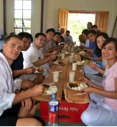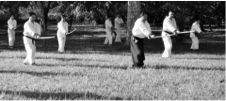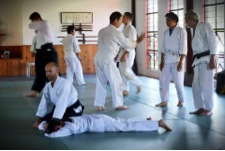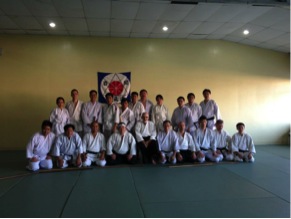1st Philippine Gasshuku
January 28 – February 4, 2014
Arriving at 10pm at the Alfonso Dojo, it was dark and silent. It’s not what we expected at all. But once we parked, several old and new faces, which were the only ones still awake, warmly greeted us. The rest of the aikidokas were already fast asleep. After some chitchat and a warm cup of tea, the rest of us tried to get some sleep as well.
One by one, people started waking up by 5am. Over coffee, warm greetings and introductions between unfamiliar faces were exchanged even when most of us were half awake. Then without anyone in particular giving orders on what needs to be done, everyone began to prepare. Some cleaned the kamidana, some cleaned the mats and some set up the benches. Saito Sensei arrived at 7am on the dot and the 1st Philippine Gasshuku has officially begun! We began with prayers and then meditation.  After which, bukiwaza immediately ensued. Saito Sensei guided us through the 1st to 14th jo suburi and the 1st and 2nd ken suburi. He corrected and reminded us of the importance of the basic and proper form. Then we moved outdoors and everyone took turns working on the tanrenuchi.
After which, bukiwaza immediately ensued. Saito Sensei guided us through the 1st to 14th jo suburi and the 1st and 2nd ken suburi. He corrected and reminded us of the importance of the basic and proper form. Then we moved outdoors and everyone took turns working on the tanrenuchi.
After the morning keiko, it was off to the market for some of the people while others stayed to set up the table. Some gathered wood and started the fire. Some diced and sliced vegetables and some cooked. We were lucky that for the duration of the gasshuku, there were a couple of helpers who did most of the cooking while the rest of us concentrated on keiko. Some served the food and water. Our meals always consisted of soup, meat or fish, vegetables and rice. After lunch, some washed the dishes while some cleaned the tables and mats.  Overall, it was a total team effort and the most wonderful thing about it is that everyone volunteered and did what they had and could do without being asked to. Even when there were tobans assigned for the following days, it didn’t really matter. Everyone still helped out and this informal arrangement went on for every meal thereafter. We all bonded in this way, showing humility and goodwill, where rank or seniority was of no concern.
Overall, it was a total team effort and the most wonderful thing about it is that everyone volunteered and did what they had and could do without being asked to. Even when there were tobans assigned for the following days, it didn’t really matter. Everyone still helped out and this informal arrangement went on for every meal thereafter. We all bonded in this way, showing humility and goodwill, where rank or seniority was of no concern.
 For afternoon keiko, we did taijutsu and keiko was quite intense! We practiced taino henko, both kihon and ki no nagare, kokyunage techniques from morotetori, katatetori and ryotetori attacks, suwariwaza shomenuchi ikkyo omote and ura, and kokyudoza. Of course, Saito Sensei reminded and corrected us on our improper forms. He showed us how to approach certain movements like in taino henko which made the execution of the movement much easier even if uke is holding onto nage really tightly.
For afternoon keiko, we did taijutsu and keiko was quite intense! We practiced taino henko, both kihon and ki no nagare, kokyunage techniques from morotetori, katatetori and ryotetori attacks, suwariwaza shomenuchi ikkyo omote and ura, and kokyudoza. Of course, Saito Sensei reminded and corrected us on our improper forms. He showed us how to approach certain movements like in taino henko which made the execution of the movement much easier even if uke is holding onto nage really tightly.
Day 2… we began the day’s training pretty much the same way but this time bukiwaza was held outdoors. With cloudy skies and a cool morning breeze, it somehow made our practice a little bit easier. Saito Sensei had a lot in store for us this morning. We first did shiho giri by doing ichi no suburi and roku no suburi. Eventually, we moved onto doing happo giri. Then we continued with the rest of the ken suburi. After which, we were asked to partner up and practiced ken awase for suburi 1, 4, 5, 6 & 7. Alas, morning keiko isn’t over yet! Saito Sensei required the boys to do tanrenuchi 200 times each and 100 times for the girls but gave us a whole day to complete the requirement. We must do this everyday. Saito Sensei got tree branches, which were heavier and harder to grip compared to our bokken, for us to use on the tanren. Of course, everyone accepted this challenge with much gusto! 
After brunch, everyone welcomed the break. Some mingled, some took naps, some scribbled down notes and discussed the pointers given by Saito Sensei. And yes, everyone used the free time to complete required number of tanren and also do ju keiko. 
Asides from the three important techniques we always practice, afternoon keiko consisted of a couple of morotetori kokyunage variations, ryokatadori kokyunage and tachiwaza shomenuchi ikkyo omote and ura. My keiko partner happened to be a friend who is practically twice as big as me and I had a hard time executing ikkyo properly without my resorting to use force rather than proper technique. Well, not that I could overpower my friend anyway. Saito Sensei approached us and showed me how to go about it. My technique is a long way from perfect but a huge relief and sense of accomplishment washed over me when I was able to pin my huge friend with so much less effort.
On the following day, a couple more people came and joined the ranks. After prayers and meditation, we went outside and completed the rest of the jo suburi. We also practiced the 31 jo kata and a few steps of the 31 jo kata awase. This time Saito Sensei had us try something totally new. Making use of the wide open spaces, Saito Sensei made us do something really bizarre. I believe it’s the first for the most if not all of us to try such a move. We had to hold the end of our jo and spin around at least 360 degrees, jump and hit an imaginary target with a shomenuchi strike and a huge kiai! It felt awkward and funny at first. I myself had a little trouble finding my balance after the spin. Saito Sensei had a huge grin while he watched and encouraged us to try it. We fumbled but luckily no one fell. Then it dawned on me! What he was trying to show us is what one can do when you find yourself surrounded by several aggressors. You spin with your jo extended to keep them at bay and then choose a target and start the attack. Cool!
Another cool thing we did was throwing shuriken! Saito Sensei showed us the kata first then how to hold and handle a shuriken properly. With relaxed shoulders and little or no power, just swing the hips and release! It was the first time for some of us to try this and it was simply a great experience! While others were lining up for their turn to throw the shuriken, the others worked on their tanrenuchi. Afternoon keiko was again an intense practice with several ushiro ryokatadori kokyunage variations and also shomenuchi nikkyo omote and ura.
In the Manila seminar, there were several marked differences compared to the training in Alfonso, Cavite. The most apparent was the weather. It was much more humid and warmer. I was already sweating just changing into my gi. Saito Sensei only prayed for a short while at the beginning of each class and we didn’t do any meditation these times. With regards to the techniques, Saito Sensei had us practice more advanced techniques. For the duration of the two-day seminar, taijustsu was practiced in the mornings. We did ni nin dori shihonage, kokyunage and nikkyo. We also did several ryokatadori kokyunage variations, ryokatatetori kokyunage, ushiro eridori kokyunage and ushiro kubishime kokyunage techniques including koshinage, nikkyo and yonkyo. In the afternoons, we did bukiwaza. We practiced with the ken doing the seven suburi and also the ken kumitachi one through three. All the kumitachi were practiced with awase and henka waza forms. Even with limited space, everyone trained really hard. Some had to stop due to sprains while others had to rest due to the heat.
Unfortunately, I myself wasn’t able to attend all the days of the Gasshuku due to personal reasons. But I was told that for the days that I missed in Alfonso, they practiced more nikkyo variations and Saito Sensei even introduced iaido. How I wish I were there! 
I must mention that all the while, Tatoian Sensei was always there translating and guiding us even if he wasn’t able to practice with us on the mats. Marelli Sensei and Takamura Sensei also helped with the English translations, which were all so invaluable. Overall, I believe that the 1st Philippine Gasshuku was a success. I had the fortune of sharing unforgettable memories with five Australians led by Marelli Sensei, two Japanese led by Takamura Sensei, two Filipinos who came all the way from Dubai and of course, the local contingent led by Supremo Sensei which includes aikidokas coming from Cebu and Naga. Making new friends while learning valuable insights makes this a most wonderful experience! Can’t wait for the next Gasshuku!
– Dennis Chua

